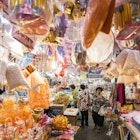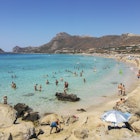
A perfect day in Odawara, Japan's historic castle town

Jan 14, 2020 • 5 min read

Originally built in 1447, Odawara Castle is the symbol of the city © David McElhinney / Lonely Planet
In the few circles in which Odawara is known, its claim to fame is having the closest feudal castle to Tokyo; it’s around 50 miles away. Yet Odawara has a raft of other historic traditions that run deep to its core: It was a land of clandestine ninja clans, martyred samurai, Shintoist spiritual underpinnings and geisha tea houses.
Like much of Japan within Tokyo’s grasp, Odawara has taken on a more modern façade in recent years, but has managed to preserve the spirit of these storied traditions. Here’s a one-day itinerary to see the best of the city in 24 hours.

Morning at Odawara Castle
Start your day at Odawara Castle, the city’s architectural pièce de résistance. In 1590, toward the end of Japan’s Sengoku (Warring States) period, the invading armies of legendary samurai Toyotomi Hideyoshi sacked this previously impregnable fortress, bringing an end to the ruling Hojo warrior clan. Approaching from its main entrance however, will provide the most un-warlike scenery: A vermillion footbridge arcs gently over the moss green outer moat, which is home to nishikigoi (brocaded carps) and paddlings of white ducks.
The main keep is a striking edifice, emblematic of the style favored by Japanese daimyo (feudal lords). A base of interlocking boulders is surmounted by a multi-tiered white stone tower with grand sloping roofs of black ceramic tiles and symbolic accoutrements protruding from the corners. Against a clear blue sky, it looks especially imposing. Head to the top of the keep for views of the undulating Fuji foothills to the west, and panoramic shots of the sprawling Sagami Bay on which Odawara is pinned, to the east.
Be sure to pay a quick visit to the castle’s resident museums. The Spirits of Samurai is a miniature gallery of ancient relics, some of which date back to the Muromachi Period (1336 – 1573) and include studded leather cuirasses, iron-plated helmets with iconic shikoro (neck guards) and Hattori Hanzo-style blades. The Odawara Castle Ninja Museum is “for kids”, but that doesn’t stop adults from paying the 310-yen ($3) admission fee. Inside you take up the role of a ninja against the invading armies of Toyotomi Hideyoshi, featuring stealth, balance, wall-climbing and evasion techniques. Plus, the introductory video told in Japanese animated melodrama (with English translation) merits a visit alone.
Next head over to Hotoku Ninomiya Shrine, a Shinto structure of deep brown timbers and a lichen smothered roof just outside the castle precinct. The glassy pond and pistoling water feature at its base are equally diverting.

An afternoon of sea views and Geisha
Take the short walk down to the Shonan coastline marking the edge of Odawara. A highway obscures the beach from view, so you’ll need to find one of the paths tunneling underneath it. It’s worth it for the dramatic seascapes which lay beyond, where aggressive, foamy waves bunch up against stony, grey shores. It becomes abundantly clear why this same coastal scenery inspired Hiroshi Sugimoto to embark upon a lifetime of creative pursuits and eventually create his magnum opus, the Odawara Art Foundation's Enoura Observatory, just 5 miles along the bay. (The observatory is a great addition to the itinerary for art buffs, but tickets must be booked well in advance.)

Next head back to the city center for lunch. The pedestrianized streets around Nishiki Dori are home to a mouthwatering raft of Japanese gustatory fare: fresh sashimi, sizzling steak, soba noodles, tempura-battered seasonal veg and yakitori chicken skewers. For cheap and cheerful sharing plates and fresh nama (drafts), head into one of the abundant izakaya (bar/restaurants) in the area.
After lunch, jump on a train for Hakone Yumoto on the Hakonetozan Line (about 15 minutes). Meet Geisha, located in a renovated old-world building by the banks of the Haya river, runs geisha performances at 4pm daily. With over 150 working geisha in the area, Hakone is second only to Kyoto, making it one of the last bastions of this ancient tradition.

Japanese-style evening feast
Before you head back to Odawara, take the free shuttle bus to Hakone Yuryo Onsen for a soak in steamy rock pools of geothermal water – don’t worry if you forgot to bring swimwear –birthday suits and same sex baths are the order of the day.
Retrace your steps to Odawara Station for dinner at Oshare Yokocho, a cavernous, lamplit alleyway of bars and restaurants, located on the station’s eastern side. Umami odors pervade the surrounding air after dark, with tonkotsu (pork bone) ramen joints and convivial yakiniku (grilled meat) shops beckoning homebound commuters inside. For a more refined meal, nip into Sushi Shiori, featuring platters of raw fish on beds of vinegered rice, with fresh wasabi and palette-cleansing ginger. And be sure to wash it down with some nihonshu (rice wine) – if in doubt of which brand to order, just say “osusume” (“the recommended one”).

More time to spare: Hayakawa Fish Market
For early risers, hit up the fish market at Hayakawa harbor (5 minutes from Odawara by train), where the morning’s catch is auctioned to local fishmongers from around 6am. If you don’t mind the 5am wake up call, it’s a great way to experience the tumult of a Japanese morning fish market: bartering fisherman, squeaking wellies and beeping forklifts, accompanied by the saline smell of fresh Pacific Ocean catch. You’ll also get unhindered views of the sun crawling up over the horizon to the east, painting the sky in the iconic pastel colors of the Japanese dawn.
For this you’ll need to stay the night in Odawara. Consider one of the guesthouses in the area. We chose Hinode Ryokan, a traditional guesthouse with a polished ceramic bathtub that heats you “from your very core” – a great addition during winter. The guesthouse may lack some frills, but with rooms starting from 4000 yen ($36), it comes at a fraction of the price of most Japanese ryokan. Plus, it will give you easy access to Hayakawa in the morning.
Produced by Lonely Planet for Odawara Tourism. All editorial views are those of Lonely Planet alone and reflect our policy of editorial independence and impartiality.
Explore related stories

Destination Practicalities
How to get your cell phone connected in Japan: eSIMs, wi-fi and mobile networksNov 20, 2024 • 6 min read

 Food and Drink6 of the best places for sushi in Kanazawa, Japan’s sushi capital
Food and Drink6 of the best places for sushi in Kanazawa, Japan’s sushi capitalOct 28, 2024 • 5 min read







